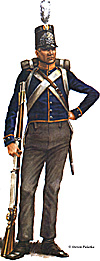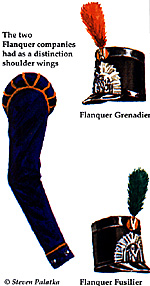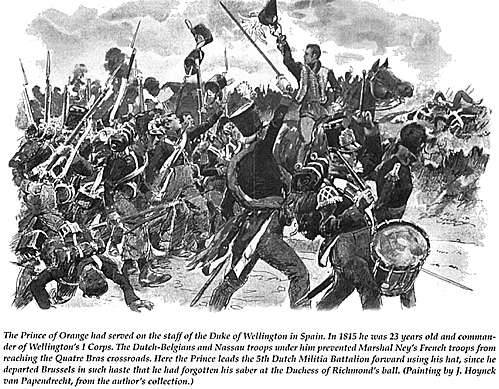 When the news reached the Netherlands headquarters at Braine le Comte that the French had crossed the Sambre River at Charleroi, orders were sent out to all the Netherlands forces to unite at their alarm posts. Since Bijlandt's Brigade was scattered it could only be assembled at its designated point in the town of Nivelles by the end of the afternoon of 15 June.
When the news reached the Netherlands headquarters at Braine le Comte that the French had crossed the Sambre River at Charleroi, orders were sent out to all the Netherlands forces to unite at their alarm posts. Since Bijlandt's Brigade was scattered it could only be assembled at its designated point in the town of Nivelles by the end of the afternoon of 15 June.
At right: Dutch Militiaman: Fusilier. © Steve Palatka
Meanwhile, the second brigade of Perponcher's division under Prince Bernhard of Saxe-Weimar had already reached its assembly point at Quatre Bras, the vital crossroads where the Nivelles-Namur route cuts the Chaussee (main road) from Charleroi to Brussels. In the evening of 15 June, Prince Bernhard's Nassau troops withstood the first probing attacks by French cavalry just north of the town of Frasnes. Pressed by the French attacks, Saxe-Weimar's troops slowly retreated to Quatre Bras. At nightfall, the French stopped the advance and set up their bivouacs.
In the afternoon of the 15th orders arrived from Wellington to concentrate the second division at Nivelles, since the Duke feared that the main French advance was to take place via Mons and that the attack upon Charleroi was merely a diversion. Obeying these orders would have meant abandoning Quatre Bras--a major strategic blunder--which would have greatly facilitated Napoleon's plan to separate Wellington's army from the Prussian army under Field Marshal Prince Blucher.
General de Perponcher, in the absence of the Prince of Orange, who had gone to attend the Duchess of Richmond's now-celebrated ball in Brussels, wisely chose to ignore Wellington's orders to concentrate his 2nd Division at Nivelles. Instead, he reinforced Saxe-Weimar by moving his remaining brigade under General Bijlandt to Quatre Bras.
The 27th Jager Battalion was ordered to move immediately to Quatre Bras. Lieutenant Colonel de Jongh, commander of the 8th Militia Battalion, received orders at 5:00 p.m. on the 15th to follow the 27th Jagers as quickly as possible to Quatre Bras and place himself under the command of the Prince of Saxe-Weimar.
 That same day the 5th Militia was near Gosselies and heard cannon fire and musketry nearby. They discovered that the Prussians were being attacked by the French. The 5th's commander, Lieutenant Colonel Westenberg, sent an adjutant to headquarters for orders.
That same day the 5th Militia was near Gosselies and heard cannon fire and musketry nearby. They discovered that the Prussians were being attacked by the French. The 5th's commander, Lieutenant Colonel Westenberg, sent an adjutant to headquarters for orders.
Dutch militia all wore similar uniforms with small differences (such as numbers on the buttons) to differentiate between battalions. Each battalion consisted of six fusilier or line companies and two elite companies: one called Flaquer Grenadiers and the other a light company called Flanquer Fusiliers. © Steve Palatka
Meanwhile the battalion prepared for battle, but no attack materialized. The adjutant returned in the evening with the order to move to Quatre Bras, where the battalion arrived at about 1:00 a.m. In the course of the night the 7th Militia also arrived. The 7th Line Battalion remained in Nivelles until it could be relieved by Chasse's 3rd Division, in case Wellington's assumption that the main French attack would be through Mons and Nivelles proved to be correct.
When General de Perponcher arrived at the crossroads at about 2:00 p.m. on the 15th, nearly his entire infantry division was present. The only cavalry available was a detachment of 50 Silesian Hussars under the command of Lieutenant Zehelin, who had been cut off from the main Prussian army. Perponcher inspected the Quatre Bras position with the Prince of Saxe-Weimar and gave orders to extend the line of defense in order to conceal its weakness. He also reinforced the troops already in place in Bossu Wood, since that forested area was the key to the Allied right flank.
Besides extending his line, Perponcher also moved his forces forward in order to put more space between his troops and the vital crossroads. At 6:00 a.m. he ordered Saxe-Weimar to move forward with the 27th Jager Battalion and the 2nd Battalion of the 2nd Nassau Line Regiment on the left of the Allied line. Both battalions advanced with a line of skirmishers in front. The Nassau battalion met little resistance, but the Jagers did not fare as well.
The skirmishers of the 1st and 6th companies drove before them the French who had taken up positions northwest of the Delhutte Wood, but were halted by intensive fire coming from the edge of the wood. Consequently, the battalion established a position east of the farm of Laraille, the bulk of it behind the farm, south of the Materne Pond. The 2nd Nassau Battalion placed itself on the same elevation, with two companies covering the woods behind and with one company in a forward position to observe Frasnes. This forward position was inspected by the Prince of Orange himself, who, satisfied with all the preparations, ordered the troops to refrain from provoking the French who had set up their bivouacs perhaps 500 paces from the very place where he stood.

More Cowards at Waterloo?
-
Introduction
The United Kingdom of the Netherlands Is Created
15 June: The French Advance
16 June: First Experience of Battle
17-18 June: Retreat to Waterloo and Infamy
Response to British Allegations by Renard
Combat Losses: Bijlandt and Allied (slow: 316K)
Back to Table of Contents -- Napoleon #16
Back to Napoleon List of Issues
Back to MagWeb Master Magazine List
© Copyright 2001 by Napoleon LLC.
This article appears in MagWeb (Magazine Web) on the Internet World Wide Web.
The full text and graphics from other military history magazines and gaming magazines are available at http://www.magweb.com
Order Napoleon magazine direct